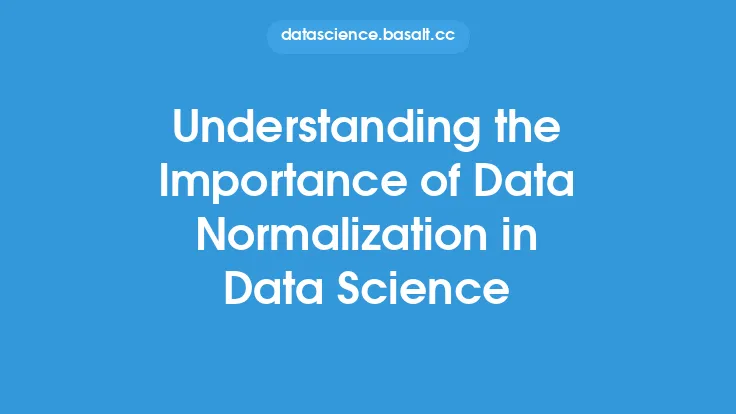In today's digital age, data has become the lifeblood of organizations, driving business decisions, operations, and growth. The increasing reliance on data has also led to a growing concern about data security, with cyber threats, hardware failures, and human errors posing significant risks to data integrity and availability. One crucial aspect of data security is data backup and recovery, which plays a vital role in ensuring business continuity, minimizing data loss, and maintaining regulatory compliance. In this article, we will delve into the importance of data backup and recovery in security, exploring the concepts, best practices, and technologies involved.
Introduction to Data Backup and Recovery
Data backup and recovery refer to the processes of creating copies of data and restoring them in case of data loss or corruption. Data backup involves duplicating data to a separate location, such as an external hard drive, tape, or cloud storage, to prevent data loss in the event of a disaster or system failure. Data recovery, on the other hand, involves restoring data from backup copies to a usable state, ensuring business continuity and minimizing downtime. Effective data backup and recovery strategies are essential for organizations to mitigate the risks associated with data loss, including financial losses, reputational damage, and regulatory non-compliance.
Types of Data Backup
There are several types of data backup, each with its own advantages and disadvantages. The most common types of data backup include:
- Full backup: A complete backup of all data, which can be time-consuming and resource-intensive.
- Incremental backup: A backup of only the data that has changed since the last backup, which is faster and more efficient than full backups.
- Differential backup: A backup of all data that has changed since the last full backup, which provides a balance between full and incremental backups.
- Synthetic backup: A backup that combines full and incremental backups to create a single backup image.
- Continuous data protection (CDP): A backup method that captures every change made to data in real-time, providing a high level of data protection and recoverability.
Data Backup Storage Options
Data backup storage options have evolved significantly over the years, offering organizations a range of choices to suit their needs. The most common data backup storage options include:
- Local storage: External hard drives, tape drives, or other local storage devices that provide fast access to backup data.
- Cloud storage: Online storage services, such as Amazon S3, Microsoft Azure, or Google Cloud Storage, that offer scalability, flexibility, and cost-effectiveness.
- Offsite storage: Remote storage facilities that provide a secure and climate-controlled environment for storing backup data.
- Hybrid storage: A combination of local and cloud storage, which provides the benefits of both worlds, including fast access to data and scalability.
Data Recovery Techniques
Data recovery techniques involve restoring data from backup copies to a usable state. The most common data recovery techniques include:
- File-level recovery: Restoring individual files or folders from backup data.
- Volume-level recovery: Restoring entire volumes or disks from backup data.
- Bare-metal recovery: Restoring a system to a bare-metal state, including the operating system, applications, and data.
- Virtual machine recovery: Restoring virtual machines from backup data, which provides a high level of flexibility and portability.
Best Practices for Data Backup and Recovery
To ensure effective data backup and recovery, organizations should follow best practices, including:
- Developing a comprehensive data backup and recovery strategy that aligns with business objectives and regulatory requirements.
- Implementing a regular backup schedule that includes full, incremental, and differential backups.
- Storing backup data in a secure and climate-controlled environment, such as a data center or cloud storage.
- Testing backup data regularly to ensure recoverability and integrity.
- Implementing data deduplication and compression techniques to reduce storage costs and improve data transfer efficiency.
- Using encryption and access controls to protect backup data from unauthorized access.
Technologies for Data Backup and Recovery
Several technologies are available to support data backup and recovery, including:
- Backup software: Programs that automate the backup process, such as Veritas NetBackup, Commvault, or Veeam Backup & Replication.
- Storage arrays: Devices that provide a centralized storage repository for backup data, such as SAN or NAS arrays.
- Cloud backup services: Online services that provide backup and recovery capabilities, such as AWS Backup or Azure Backup.
- Tape libraries: Automated tape storage systems that provide a high-capacity storage solution for backup data.
- Virtualization technologies: Platforms that provide a virtualized environment for backup and recovery, such as VMware or Hyper-V.
Challenges and Limitations
While data backup and recovery are essential for business continuity, several challenges and limitations exist, including:
- Data growth: The rapid growth of data volumes, which can make backup and recovery processes more complex and time-consuming.
- Complexity: The increasing complexity of IT environments, which can make it difficult to develop and implement effective backup and recovery strategies.
- Cost: The high cost of backup and recovery solutions, which can be a barrier to adoption for small and medium-sized businesses.
- Security: The risk of data breaches and cyber attacks, which can compromise backup data and make recovery more difficult.
- Compliance: The need to comply with regulatory requirements, such as data retention and privacy laws, which can add complexity to backup and recovery processes.
Conclusion
In conclusion, data backup and recovery are critical components of data security, providing a last line of defense against data loss and corruption. By understanding the concepts, best practices, and technologies involved, organizations can develop effective data backup and recovery strategies that ensure business continuity, minimize data loss, and maintain regulatory compliance. As data volumes continue to grow and cyber threats evolve, the importance of data backup and recovery will only continue to increase, making it essential for organizations to prioritize these processes and invest in the necessary technologies and expertise to support them.





